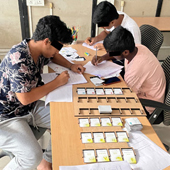Design Case study
Game-based Learning to Teach Computational Thinking
Learning approach for high school students
by
Design process that was followed in this project:
• Introduction
• Content
- Why Computational thinking?
- What is Computational Thinking?
- Comparison between Design thinking and computational thinking
- Importance of Computational thinking
- Concepts in Computational Thinking
- Scope of project
- Concepts in focus
. Decomposition
. Pattern Recognition
. Abstraction
. Algorithm
- Ways of Learning CT
- Directions to explore
• Literature review
- Piaget’s Theory of Cognitive Development
- Theories on Play
- Caillois’s Attitudes in Play Experience
- Csikszentmihalyi’s Flow Theory
- Play Pyramid by Kudrowitz and Wallace
- Theories on Learning
- Relationships of CT, pedagogy of programming, & Bloom’s Taxonomy
- Frameworks of game design
• Secondary Research
- Market study
- Tangible product
. Taco coding by play shifu
. Tangiplay
. Google Project Bloks
- Visual coding language / interface
. SCratch
. MIT App inventor
. Agent Sheets / Agent cubes
. Google Project Bloks
- Games
. Lightbot
. CodeSpark
. Algorithm city
. Human resource machine
. The case study of Crabs and Turtles
. RaBit EscApe:
- Market study insights
- Informal interview with teachers
• Defining
- Various ways to do CT
- Skill needed to perform CT
- Requirements to create the game:
- Defining learning objectives
• Ideations
- Ideation based on topic
- Pattern recognition using tangrams
- Shoot a question”, to lean decomposition
- Instruct” to teach Algorithm
- Ideation based on context
- A new Crafting system
- Computer science game
- “Object forming” game
- Construction game
- Idea Selection
• Content design of the game
• Game Design
- Game Placement
. Game Elements
. Game setting
. Player Actions
. Winning conditions
. The game flow starts from here
. Scaffolding for providing Instruction in algorithm mode
. Previous Iterations 54
. Results of Games 55
- Gameplay from the player's point of view 56
- Where and when they learn CT in the gameplay
• Evaluation
- Evaluation method
- Game quality Evaluation using the MEEGA+ model
. Quantitative results for measuring game quality
. Inference
- Qualitative analysis
. Observations:
. Strong aspects of the game
- Learning evaluation
. Think aloud analysis on gameplay
- Improvements
• Conclusion
• References
- Publications
- Tables
- Figures
Case Study Download:
• Game-based Learning to Teach Computational Thinking......










































































